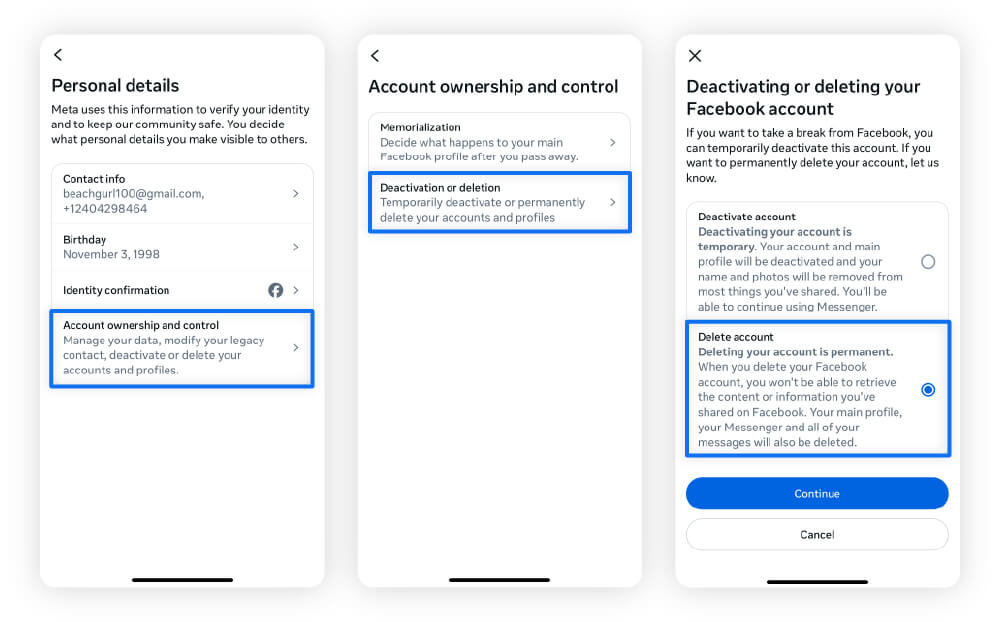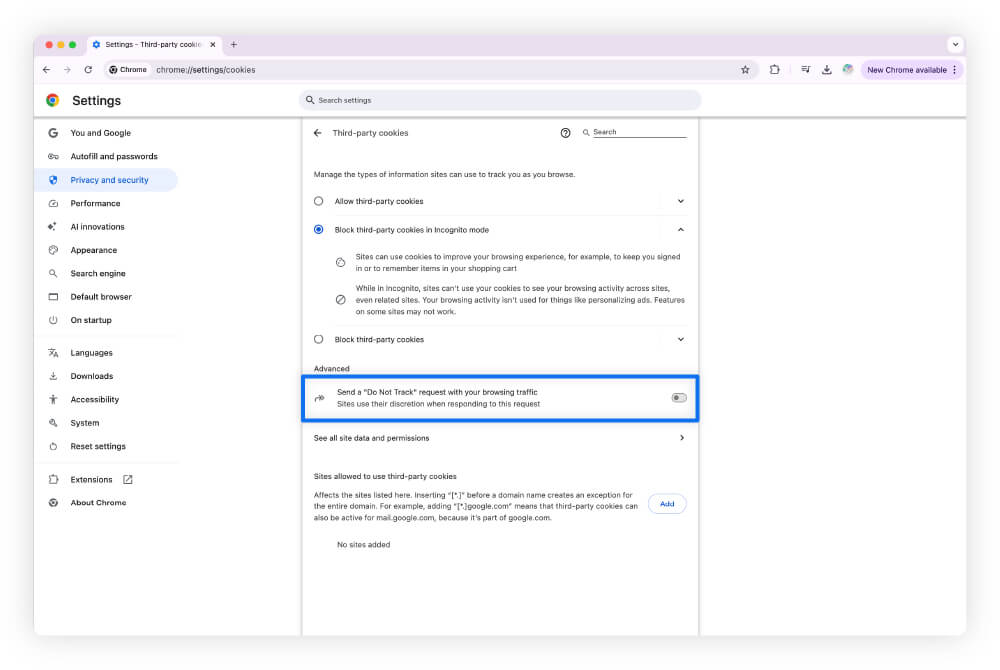Your personal information is likely scattered across the internet — often collected, bought, and sold by data brokers without your knowledge. In fact, the data broker market is expected to reach more than $600 billion by 2030, making it harder than ever to keep your private details out of reach.
The best way to protect your information is not to share it online in the first place. But although you can’t delete your information from the internet entirely, we’ll walk you through multiple ways to reduce the amount of personal data floating around cyberspace.
1. Delete your social media accounts
Make a list of your social media accounts — like Facebook and Instagram — but think back to older platforms like MySpace or LiveJournal, too. The more accounts you have, the more personal information is lying around online.
To start reducing your digital footprint, visit each platform, navigate to account settings, and look for the option to delete your account (sometimes you have to deactivate it first).
Here’s how to delete popular social media accounts from a phone:
- X (formerly Twitter): Tap the three-line icon > Settings and privacy > Your account or Account >, then choose Deactivate your account. (Note: Your account will then be permanently deleted if you don’t access it in 30 days.)
- Instagram: Open your profile and tap the three-line icon> Accounts Center > Personal details > Account ownership and control > Deactivation or deletion, then select Delete account.
- YouTube: Visit YouTube Studio > Settings > Channel > Advanced Settings, then select I want to permanently delete my content.
- TikTok: Tap Profile at the bottom, then the three-line icon at the top > Settings and privacy > Account > Deactivate or delete account > and follow the instructions to delete it.
- Facebook: Click your profile picture (desktop) or the three lines (phone) at the top > Settings & Privacy > Settings > Accounts Center > Personal details > Account ownership and control > Deactivation or deletion, then tap Delete account.


If you don’t want to delete your accounts, deactivating or updating your privacy settings is an alternative to keep your information more private. But remember, these accounts could still be vulnerable to social media hackers.
2. Ask data brokers to delete your information
Data brokers collect and sell as much legally accessible information as possible, aggregating data from public records and compiling it online for sale to third parties. This may include your name, date of birth, phone numbers, addresses, land and marriage records, social media profiles, and more.
But by opting out and removing yourself from data broker sites, you can help prevent identity theft by limiting access to your information and reducing the risk of it being misused or falling into the hands of bad actors.
To remove yourself from data broker sites, follow these steps:
- Search for your information: Google your name, followed by “data broker,” to see where your information lives. Popular sites include Acxiom, Spokeo, and PeopleFinder.
- Create a list: Note the sites that display your personal information.
- Fill out the opt-out forms: Visit each site and follow the procedures for opting out.
An easier way to remove your personal info online is to subscribe to an identity theft protection service like LifeLock Standard, which has a powerful Privacy Monitor feature that scans common public people-search websites for your data and helps you opt out.
3. Ask Google to remove your search results
Search engine results can expose a lot of hidden trails of personal information. Much of it may be harmless by itself, but put together, it could be quite revealing. If you find personal information displayed, you can request to have it removed from Google Search.
Here’s how the process works:
- Fill out Google’s form to submit your request, and you’ll receive a confirmation email.
- Google will review your request and may ask for additional information if needed.
- You’ll receive a status update via email either confirming the removal or explaining why your request doesn’t meet the removal requirements.
4. Remove unnecessary apps from your phone
Many apps collect personal details like your name, email, spending habits, and location, which could leak or be hacked. It’s smart to go through your apps regularly and remove those you’re not using to lower your risk of information exposure — and free up space as a bonus.
How to delete an app on iPhone:
- Before deleting the app from your phone, make sure you delete your account.
- Then, tap and hold the app icon on your home screen.
- Tap Remove App, then select Delete App to uninstall it.
- Tap Delete to confirm.


How to delete an app on Android:
- Before deleting the app from your phone, make sure you delete your account.
- Then, tap and hold the app icon on your home screen.
- Tap Uninstall, then Uninstall again to confirm.
5. Tell websites and apps not to track you
Cookies are data files that track your web browsing habits. If you don’t want that information tracked and stored, opt out by disabling tracking in your web browser and adjusting your account privacy settings to limit tracking.
Here’s how to disable cookies on Google Chrome:
- Open Chrome and navigate to Settings.
- Click Privacy and security and then third-party cookies.
- Select Block third-party cookies.
- Next, under Advanced, toggle on Send a "Do Not Track" request with your browsing traffic.
- Click Confirm.


It’s important to note that browser privacy settings, including Do Not Track, have limitations. For example, your browsing activity might still be visible to the websites you visit, your employer or school (if you’re on their networks), and your internet service provider.
6. Delete unnecessary accounts
To safeguard your personal information, delete any accounts you no longer use, including old emails, blogs, online shopping profiles, and other accounts vulnerable to data breaches.
If you’ve used Google to sign up for accounts, review saved logins in Google’s Password Manager and check the "Your connections to third-party apps & services" section to find and manage linked accounts.
7. Clean up your emails
Your email inbox holds valuable insights into your online presence, including the accounts you've created, where your personal information is stored, and which companies have access to your data. Reviewing old marketing emails and account notifications can help you identify and close accounts you may have forgotten about.
Hackers are aware that emails contain a wealth of personal information, which is why accounts often end up on the dark web. Regularly cleaning up your inbox can help protect your data in the event of a direct hack, reducing the risk of sensitive information being exposed.
Here’s where to start:
- Organize your inbox: For easier management, use folders and filters to organize your inbox into categories like finances, personal, work, and travel bookings.
- Unsubscribe from unwanted emails: Go through your inbox and unsubscribe from any marketing communications that you no longer want to receive.
- Delete linked accounts: If you used your email to sign up for accounts you no longer use, delete them to reduce security risks.
8. Remove images from Google Maps
Google Maps is great for getting directions, updates on traffic conditions, and Street View imagery. But while Google takes care to blur identifiable faces and license plates in Street View, other details may still be visible, potentially compromising your privacy.
The platform also features numerous photos of popular locations or restaurants you might want to visit, and you may have contributed some of your own. If you want to improve your privacy on Street View or delete your Google Maps photos, we’ll show you how.
Blur images on Street View
To enhance your security, Google allows you to request additional blurring of Street View imagery. Here’s how:
- Open Google Maps and search for your home address, or the address in question.
- Select the Street View photo that you want blurred.
- Click Report a Problem in the bottom right corner.
- Fill out the form and submit your request.
Delete your Google Maps photos
User-uploaded photos on Google Maps are visible to everyone and are not blurred. If you’ve uploaded sensitive images, such as personal photos, license plates, or identifiable locations, it’s important to remove them.
You may not even realize you’ve uploaded such images — just as you’ve likely been surprised by photos from other users. It’s an easy mistake to make!
Here’s how to find and delete your photos on mobile:
- Open the Google Maps app and tap Contribute in the bottom right corner.
- Select See contributions and review your photos and videos.
- Select the photo or video you want to delete and tap the three dots or Remove.
- Tap Delete or Delete this photo to remove the image from Google Maps.
9. Hide your public records
Public records, which may include your name, address, and date of birth, are accessible to anyone and can pose a security risk. These records include voter registration, marriage certificates, and property records. While you can’t remove all public records, some states allow you to limit access to certain personal information to enhance your privacy.
States like California and Virginia have data privacy laws (the California Consumer Privacy Act and the Virginia Consumer Data Protection Act) that provide residents with greater control over their personal information. To better protect your data, review your state's privacy laws and explore options for restricting access to your personal information.
10. Monitor your online presence
Removing personal information from the internet is not a one-and-done process, as new data seeps online almost continuously, and identity risk can emerge dynamically. It's important to monitor your online presence vigilantly, but doing so can be time-consuming, and you may miss something important.
Some identity theft protection services like LifeLock Standard can help handle this for you by regularly scanning common data broker sites for your personal information, notifying you when your data is found on the dark web, and alerting you to potentially fraudulent use of your details.
11. Secure your accounts
To help prevent hackers from accessing your information via account takeover attacks, secure each of your online accounts, especially your email, as it probably holds a wealth of personal data.
Follow these tips to safeguard your accounts:
- Use strong passwords: Each account should have a unique, complex password, so consider using a password manager to store it securely.
- Enable two-factor authentication (2FA): Set up 2FA for all your accounts as added protection against unauthorized login attempts.
- Keep software up to date: Regularly update software so you have access to the latest security patches and features.
How can my personal information land on the internet?
Your personal information can end up on the internet in various ways, from your own social media profile to large-scale data breaches.
Here’s a closer look at how personal information can get exposed:
- Data breaches: These occur when unauthorized individuals break into databases to steal and release personally identifiable information (PII), sometimes exposing it on the dark web.
- Data leaks: If a company you have an account with experiences a data leak, your information could be exposed.
- Data brokers: These companies compile your personal information and then sell it or share it for free (e.g. people-search sites), making it much easier for scammers to target victims.
- Social media and blogs: Your accounts may contain interesting nuggets of information, especially if you overshare online.
- Online accounts: The more accounts you create, the more chance there is that your data will be swept up in a leak or breach.
- Web browsing: Companies and internet providers use cookies to track your browsing for targeted ads, but hackers can exploit this data to scam you or invade your privacy.
Take control of your online privacy
While removing your personal information from the internet is a great first step, keeping it off is trickier. Subscribe to LifeLock Standard to protect against identity fraud and help reduce public exposure of your personal information. Plus, you’ll have U.S.-based personal restoration specialists standing by to help you if your identity is compromised.
FAQs
Can you remove your personal information from the dark web?
In most cases, it’s not possible to remove your information from the dark web. However, dark web monitoring services, a feature included in the LifeLock Standard identity theft protection subscription, can notify you if your information is found, allowing you to take steps to protect yourself and secure compromised accounts.
How much does removing info from the web cost?
The cost of removing your information from the web can vary. You can remove personal data from your social media accounts and contact data brokers directly to request opting out of their sites for free. Alternatively, you can pay for a monitoring service, some of which offer comprehensive identity theft protection.
How long does Google keep personal information?
Google retains data for specific timeframes based on its purpose. For example, Google anonymizes advertising data stored in server logs by deleting part of the IP address after nine months, and cookie data after 18 months.
Can you make public information private?
In most cases, you cannot make public information private. However, you can request the removal of personal details from specific sources, such as people search websites and other data broker platforms.
Editor’s note: Our articles provide educational information. LifeLock offerings may not cover or protect against every type of crime, fraud, or threat we write about.
This article contains
- 1. Delete your social media accounts
- 2. Ask data brokers to delete your information
- 3. Ask Google to remove your search results
- 4. Remove unnecessary apps from your phone
- 5. Tell websites and apps not to track you
- 6. Delete unnecessary accounts
- 7. Clean up your emails
- 8. Remove images from Google Maps
- 9. Hide your public records
- 10. Monitor your online presence
- 11. Secure your accounts
- How can my personal information land on the internet?
- Take control of your online privacy
- FAQs
Start your protection,
enroll in minutes.
LifeLock is part of Gen – a global company with a family of trusted brands.
Copyright © 2025 Gen Digital Inc. All rights reserved. Gen trademarks or registered trademarks are property of Gen Digital Inc. or its affiliates. Firefox is a trademark of Mozilla Foundation. Android, Google Chrome, Google Play and the Google Play logo are trademarks of Google, LLC. Mac, iPhone, iPad, Apple and the Apple logo are trademarks of Apple Inc., registered in the U.S. and other countries. App Store is a service mark of Apple Inc. Alexa and all related logos are trademarks of Amazon.com, Inc. or its affiliates. Microsoft and the Window logo are trademarks of Microsoft Corporation in the U.S. and other countries. The Android robot is reproduced or modified from work created and shared by Google and used according to terms described in the Creative Commons 3.0 Attribution License. Other names may be trademarks of their respective owners.





